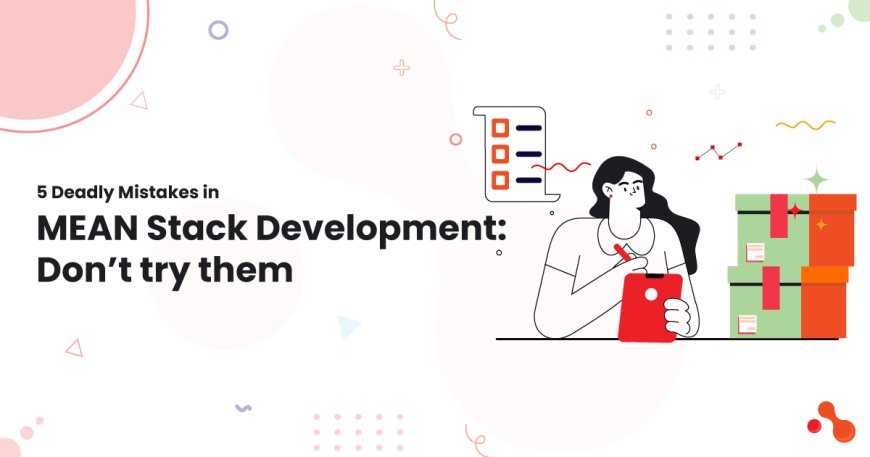5 Deadly Mistakes in MEAN Stack Development: Don’t try them
MEAN Stack development is a popular web app development stack but only if executed effectivelyRead the blog to avoid mistakes.

Introduction
Building a web application with MEAN stack, comprises elements like MongoDB, Express.js, Angualr.js and Node.js which are a blend of powerful platforms to build a responsive and dynamic website and application.
Even with the powerful tools listed above, a developer may occasionally run into a few architectural difficulties that result in a rigid solution. To obtain a scalable and adaptive design, it is critical to comprehend the obstacles and how to avoid them.
We’ll discuss some typical blunders in this blog post, along with tips for building a more adaptable MEAN stack project. Additionally, we’ll comprehend a few aspects of MEAN Stack Development. Are you prepared to start now?
Let us first clarify what MEAN Stack Development is.
What does MEAN Stack stand for and mean?
The term “MEAN Stack” describes the process of building websites and applications with a select group of tools, such as Express.js, Angular.js, Node.js, and MongoDB. Since all of the aforementioned components are JavaScript-based, MEAN stack functions as a single programming environment for client-side and server-side development.
When developing dynamic websites and applications, MEAN Stack development is popular because it enables quick development using only JavaScript, from a client to a server to a database. A MEAN Stack is renowned for its ability to accommodate large-scale projects, real-time applications, and everything in between while producing efficiency and flexibility.
Let’s now discuss some data around MEAN Stack Development before going into its components and parameters.
MEAN Stack & Its game of Statistics
In order to appreciate the significance of MEAN Stack development, let’s examine some fascinating statistics:
- One study from the Stack Overflow Developer Survey 2021 states that JavaScript is a widely used programming language for web development, with 67.8% of respondents using it for this purpose.
- One of the most crucial parts of any MEAN Stack, Angular, has over 1.2 million packages downloaded from npm each week, which contributes to its popularity.
- The NoSQL database MongoDB, which is part of a MEAN stack, is growing in popularity quickly. According to the Stack Overflow Developer Survey for 2021, it is regarded as the sixth most popular database.
As more firms begin utilizing the MEAN stack for their projects, specialized businesses that concentrate solely on this kind of tech stack.
Further, let’s understand the advantages and challenges of MEAN Stack development
MEAN Stack Development: Its Advantages and Challenges
Feature Advantage Challenge Unified Language (JS) Streamlines development by using JavaScript across all layers of the stack. Requires comprehensive JavaScript knowledge. MongoDB Flexible data schema suits varied data types and is scalable. Complex queries can be less efficient than SQL databases. Express.js Simplifies routing and middleware integration. Can be less intuitive for beginners compared to other frameworks. Angular Provides a structured framework for building dynamic SPAs. Steeper learning curve; requires understanding of TypeScript and MVC concepts. Node.js Enables non-blocking I/O operations, enhancing performance. Handling CPU-bound tasks can be tricky without proper design.
Now, quickly let us understand the Common mistakes in any MEAN Stack development project.
Common Mistakes in MEAN Stack Development Project
Ignoring the Modular Design Issue
If a modular design isn’t implemented, a tightly connected component may result, making it challenging to scale or adapt the program.
Solution: It may be a good idea to start with a modular strategy. An efficient way to solve an application’s problems is to divide it up into smaller, independent modules that are built, updated, and scaled.
Ignoring Database Schema Design Issue
Because MongoDB lacks a schema, developers may undervalue the significance of a carefully considered database schema, which could result in inefficient data update and retrieval.
Solution: Take the effort to create a logical structure that satisfies the data needs of your application. Utilize the schema validation capabilities of MongoDB to guarantee data integrity.
Underestimating the Problem of API Design
Inadequately constructed APIs can restrict the scalability and flexibility of MEAN stack apps, making future growth or service integration difficult.
You should consider scalability and flexibility when designing RESTful APIs. Ensure that your API endpoints can handle versioning and future updates, and logically organize them.
Ignoring recommended security practicesIss
Although security is frequently overlooked, failing to follow security best practices in the beginning can result in vulnerabilities that are difficult to fix later.
Solution: From the beginning, put security best practices into effect. These include secure communication protocols, authentication and authorization techniques, and input validation.
Over-dependence on Packages from Third Parties
Using npm packages excessively without doing adequate vetting can lead to bloat and security issues, even though they can greatly speed up development.
Solution: Choose third-party software carefully after evaluating them. Review and update them frequently to reduce security flaws and maintain the application’s slenderness.
Let’s now examine the process of creating a flexible MEAN Stack architecture.
Building a Flexible MEAN Stack architecture — A 10 Step process
Creating a flexible MEAN (MongoDB, Express.js, Angular, Node.js) stack architecture is about building a system that’s not only robust but also adaptable to changing needs and scales. Let’s walk through a more relatable, step-by-step approach to setting this up:
Step 1: Understand What You Need
Start by getting a clear picture of what you need from your application. Think about who will use it, how many people might use it at once, and what kind of data you’ll handle. This is like planning a trip: knowing your destination helps you choose the right path and preparations.
Step 2: Laying the Foundation with MongoDB
Think of MongoDB as your adjustable shelving system, where you can move shelves around depending on what you need to store. Design it to handle whatever data comes its way, whether that’s a lot at once or very complex data sets. Use MongoDB’s built-in features to make sure it can grow with your needs, and keep your data safe and accessible.
Step 3: Build a Sturdy Backend
Use Node.js as the backbone of your server-side operations — it’s the steady base where your application logic lives. Express.js acts like a helpful assistant, handling the details of requests and responses, making sure data goes where it needs to safely and efficiently.
Step 4: Create a Dynamic Frontend
Angular is your artist, crafting the part of your application users will see and interact with. Organize your Angular project so that each part (components, services, and modules) has a clear role, much like organizing a team where everyone knows their job. This keeps things efficient and easier to manage as your app grows.
Step 5: Make Sure Everyone Speaks the Same Language
Ensure that the frontend and backend can talk to each other smoothly. Think of this like setting up good communication in a team is important. Decide whether to use RESTful APIs or something more complex like GraphQL, depending on your needs. Use effective communication tools to make the planned communication easier.
Step 6: Secure the Gates
Just like you’d secure your home, secure your application.Users should use proven methods like JWT (JSON Web Tokens) to prove their identities to the application and manage their permitted actions.
Step 7: Prepare for Growth
Your application might start small, but you want it to handle growth without stumbling. Use tools like load balancers to manage traffic, and consider using technologies like Docker and Kubernetes to make scaling up simpler. Think of it like planning a city, good infrastructure makes everything run smoother.
Step 8: Keep It Running Smoothly
Set up automated tests to catch problems early, just like regular health check-ups. Use CI/CD tools to keep your application updated and deliver new features safely, automatically.
Step 9: Keep an Eye on Things
Monitor your application’s health using tools designed to give you insights into how everything is running. It’s like having a dashboard in your car — you can see if something needs attention before it becomes a bigger problem.
Step 10: Document Everything
Keep good records of how things work, just like you’d keep a user manual for a complex device. This makes it easier for anyone new to quickly understand and work with your application, and it’s invaluable for future maintenance.
By taking these steps, you’re not just building a software application; you’re crafting a dynamic, efficient community that can grow and adapt to meet whatever challenges come its way.
Now, let us understand how I can help you in building an efficient MEAN Stack Architecture.
How can Acquaint Softtech help?
Acquaint Softtech is an outsourcing software development company and IT Staff augmentation company. We provide help to organizations to fill skill scarcity gaps by helping them hire remote developers. Our hourly rate for remote devs is $15.
We offer MEAN stack development and MERN stack development services as an official Laravel Partner, giving you the option to hire MEAN stack developers or MERN stack developers to handle your development requirements.
Our talented development team can help if you’re having trouble with software development projects or web app development.
Wrapping Up!
Embracing the MEAN stack development power with your web development needs to be provided with a smooth path, from concept to completion, guaranteeing the effectiveness and proving it for your applications.
It’s important to be aware of a few common pitfalls when starting or enhancing your projects, rather than having them steer clear of these issues.Any organization should ensure they avoid these mistakes of MEAN development to build a flexible architecture. Moreover, knowing all the parameters for MEAN Stack development should be kept in check.
At Acquaint Softtech, we guide you through flexible architecture, and our team stands ready to bring our expertise into your unique challenges. Lean on us and use the power of the MEAN stack to build strong, scalable applications that drive your business forward.
What's Your Reaction?



























